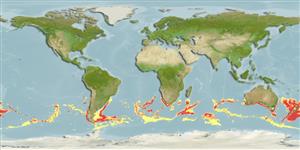>
Lophiiformes (Anglerfishes) >
Ceratiidae (Warty Seadevils)
Etymology: Ceratias: Greek, keras = horn or horned, refers to the lure projecting from the snout (Ref. 86949).
More on author: Norman.
Environment: milieu / climate zone / depth range / distribution range
Écologie
marin bathydémersal; profondeur 100 - 2900 m (Ref. 75154). Deep-water; 26°S - 69°S
Southern Ocean. Also known from Mozambique and South Africa.
Taille / Poids / Âge
Maturity: Lm ? range ? - ? cm
Max length : 88.0 cm TL (female)
Épines dorsales (Total): 1; Rayons mous dorsaux (Total): 4; Épines anales 0; Rayons mous anaux: 4. Distinguishing characteristics of metamorphosed female: pair of distal esca appendages; illicium length 19.1 to 28.2% SL; presence of 2-6 vomerine teeth in large specimens; darkly pigmented proximal one-half to two-thirds of escal bulb, oval shaped distal portion, proximal portion tapering into stem of illicium; 2 slender escal appendages arising anterior to escal pore, each appendage nearly always bifurcate, trifurcate or multibranched; escal pore at apex of bulb, raised on pigmented papilla in specimens 75 mm and larger (Ref. 86949).
Majority of collected materials taken by trawls that reaches maximum depth of greater than 650m (Ref. 86949).
Life cycle and mating behavior
Maturité | Reproduction | Frai | Œufs | Fécondité | Larves
Pietsch, T.W., 1990. Ceratiidae. p. 210-211. In O. Gon and P.C. Heemstra (eds.) Fishes of the Southern Ocean. J.L.B. Smith Institute of Ichthyology, Grahamstown, South Africa. (Ref. 5185)
Statut dans la liste rouge de l'IUCN (Ref. 130435)
Menace pour l'homme
Harmless
Utilisations par l'homme
Pêcheries: sans intérêt
Plus d'informations
RéférencesAquacultureProfil d'aquacultureSouchesGénétiqueElectrophoresesHéritabilitéPathologiesTraitementNutrientsMass conversion
CollaborateursImagesStamps, Coins Misc.SonsCiguateraVitesseType de nageSurface branchialeOtolithesCerveauxVision
Outils
Articles particuliers
Télécharger en XML
Sources Internet
Estimates based on models
Preferred temperature (Ref.
123201): 2 - 8.4, mean 4.5 °C (based on 779 cells).
Phylogenetic diversity index (Ref.
82804): PD
50 = 0.6875 [Uniqueness, from 0.5 = low to 2.0 = high].
Bayesian length-weight: a=0.01995 (0.00906 - 0.04395), b=3.01 (2.83 - 3.19), in cm total length, based on all LWR estimates for this body shape (Ref.
93245).
Niveau trophique (Ref.
69278): 3.3 ±0.4 se; based on size and trophs of closest relatives
Fishing Vulnerability (Ref.
59153): High vulnerability (55 of 100).
